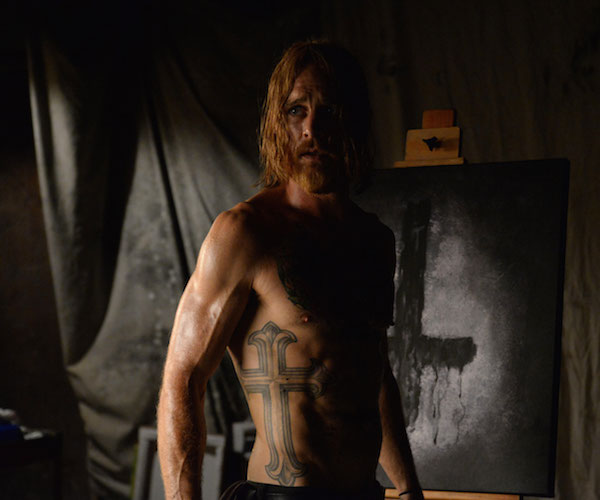Film Review: “The Devil’s Candy” — Wouldst Thou Like to Die, Deliciously?
Horror fans in search of a smarter-than-average thriller that will make their hearts race and their viscera quiver should not miss this one.
The Devil’s Candy, directed by Sean Byrne. Screening at Coolidge Corner Theatre, Brookline, MA, through March 25.

Ethan Embry in a scene from “The Devil’s Candy.”
By Peg Aloi
It’s not uncommon for critics to use the phrase “not for the faint of heart” to quaintly warn audiences that a film is disturbing, graphic, violent, gruesome, etc. That venerable expression is a very appropriate warning for Tasmanian filmmaker Sean Byrne’s The Devil’s Candy, a terrifying and suspenseful tale of a haunted house whose previous resident has some unfinished business.
The Hellman family (note the name? heh heh) is not your typical hipster trio: Jesse (seen in TV’s Once Upon a Time and Grace and Frankie) and wife Astrid (TV actress Shiri Appleby, from UnREAL and Girls) are taking a leap and buying their first house. It’s a big step, financially: He’s a painter whose lurid visions have garnered some gallery interest but, he laments, he has to paint corporate-friendly “butterfly paintings for banks” to pay the bills. Jesse also wears his hair long and listens to harsh metal music constantly. The realtor informs them that there were two deaths in the house: a woman fell down the stairs to her death, and her grief-stricken husband killed himself. But they decide to move in, and a peppy montage shows them furnishing and decorating with bohemian aplomb.
Teenage daughter Zooey (Canadian TV actress seen in Bitten and Copper), thinks her rocker parents are cool (she loves her dad’s metal head bobble-head doll on the dashboard), but she is having a tough time at her new school, despite her blue hair and sweet wisecracking. One day a strange man knocks at the door. Zooey answers, somewhat taken aback when he stares intently at her. The man is nervous and awkward, and says he needs to move back into the house; it turns out that he is the son of the previous owners. This is Ray Smilie, played by the always-excellent Pruitt Taylor Vince (The Walking Dead, True Blood, Deadwood). He is an actor who has made a career out of playing unsettling characters, owing in part to his imposing size and an unusual condition (nystagmus) that triggers involuntary movements in his eyes — they always seem to be darting back and forth. His Ray Smilie is friendly and childlike, but something about him isn’t quite right. Zooey and Astrid pity him, but Jesse insists that it is their house now, and he needs to leave.
We are soon given a flashback that shows Ray doing violence to a young child: the first sign that we’re in for a horrific story. Jesse begins to have strange visions of children and is compelled to include them in his butterfly paintings. Ray comes to the house and tries to abduct Zooey. She escapes and the police promise 24 hour protection — but the household is shaken. Jesse continues to have dark visions of children and, to Astrid’s horror, his own daughter’s face appears in one of his paintings. He also has a vision of a goat-headed demon that appears in an enormous picture with several sets of evil black eyes. When Zooey is abducted a second time, the film’s pace picks up and a chilling sense of dread and danger enters the story.
Heavy metal music underscores most of the action, partly because it’s what Jesse listens to when he paints, but also because it’s the Devil’s favorite music. It turns out that Ray is under the control of none other than Lucifer Himself. The guy refers to children as “the devil’s candy” and insists he must bring his dark lord and master what He wants.
All of this makes the film very unsettling to watch. Layers of horror tropes — occultism, devil worship, insanity, disappearing children, and flat out cold-blooded violence with any number of weapons — are combined to make a visually complex yet terrifyingly straightforward narrative. I sometimes felt as if I was watching a Rob Zombie film, given the heavy metal iconography, the long-haired aging rocker protagonist in his vintage station wagon, the haunted and unsafe house motif, etc. But Zombie would have varied the soundtrack with some soulful 1970s rock and roll, instead of keeping it constantly amped-up with death metal. Still, it’s clear that Byrne’s style is influenced by Zombie, given the nightmarish visuals.
The performances (including a cameo from character actor Tony Amendola, also seen in Once Upon a Time) are consistently effective, to the point that the film overcomes its potentially-exploitative story elements to offer some very artfully crafted horror. What’s more, there’s an ambiguous ending that feels both redemptive and foreboding. Horror fans in search of a smarter-than-average thriller that will make their hearts race and their viscera quiver should not miss this one.
Peg Aloi is a former film critic for The Boston Phoenix. She has taught film studies for a number of years at Emerson College and is currently teaching media studies at SUNY New Paltz. Her reviews have appeared in Art New England and Cinefantastique Online.
